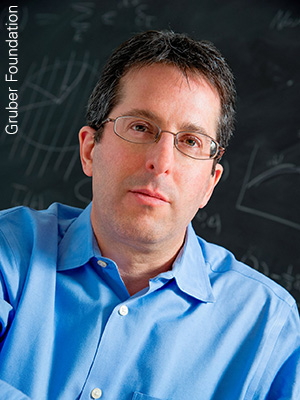Marc Kamionkowski Receives 2021 Gruber Cosmology Prize
This post is adapted from a Gruber Foundation/Yale University press release:
 AAS member Marc Kamionkowski (Johns Hopkins University) will receive a share of the 2021 Gruber Cosmology Prize along with Uroš Seljak (University of California, Berkeley, and Lawrence Berkeley National Laboratory) and Matias Zaldarriaga (Institute for Advanced Study).
AAS member Marc Kamionkowski (Johns Hopkins University) will receive a share of the 2021 Gruber Cosmology Prize along with Uroš Seljak (University of California, Berkeley, and Lawrence Berkeley National Laboratory) and Matias Zaldarriaga (Institute for Advanced Study).
The prize, which is cosponsored by the International Astronomical Union, honors a leading cosmologist, astronomer, astrophysicist, or scientific philosopher for theoretical, analytical, conceptual, or observational discoveries leading to fundamental advances in our understanding of the universe. Kamionkowski, Seljak, and Zaldarriaga are being recognized for their contributions to methods essential for studying the infant cosmos. The three will equally share the $500,000 award, and each will receive a gold medal at a ceremony that will take place in August at the 24th International Conference on Particle Physics and Cosmology conference at the University of Illinois and online.
Many of the techniques developed by these three physicists focus on the cosmic microwave background (CMB), the relic radiation that dates to the era of decoupling — when atoms and radiation emerged from the developing universe’s primordial plasma and went their separate ways. The atoms remain in the form of the matter in the universe, and the radiation remains in the form of a background “noise” that pervades space in every direction, providing an image of the universe when it was only 379,000 years old. That same “baby picture” of the universe, however, serves as an observational limit.
As a key part of this work, Kamionkowski (with Arthur Kosowsky of the University of Pittsburgh and Albert Stebbins of Fermilab) and, independently but simultaneously, Seljak and Zaldarriaga found a mathematical means to use the radiation from the CMB to infer what’s on the other side, all the way back to the first fraction of a fraction of a second of the universe’s existence. That method involves polarization — the degree to which electromagnetic waves, oscillating perpendicular to their direction of travel, oscillate in the same plane. The two teams' papers appeared side by side in Physical Review Letters in 1997. Their impact was seismic, the reverberations enduring.
By observing polarization in the CMB, cosmologists can match theoretical predictions of early universe properties using data that would otherwise be inaccessible. Among the observatories that have used polarization to make those measurements are the WMAP and Planck satellites (whose principal investigators and teams received the Gruber Cosmology Prize in 2012 and 2018, respectively). Those measurements have allowed cosmologists to determine that the universe is 13.8 billion years old and comprises roughly 5% ordinary matter, 26% dark matter, and 69% dark energy.
Yet as powerful as polarization has proven to be in probing the early universe, it is now inspiring a new generation of research programs that will detect — or not — the final piece in that reigning cosmological model: inflation, a theoretical moment at the very beginning of the universe’s existence when space would have undergone an expansion of almost unfathomable proportions. (The theorists who independently created that idea, Alan Guth and Andrei Linde, received the 2004 Gruber Cosmology Prize.) The two 1997 papers by Kamionkowski, Seljak, and Zaldarriaga identified a signature in the CMB polarization that would render a verdict on the existence of primordial gravitational waves — a key prediction of inflationary theory.
Although the 1997 papers are two of the seminal works by Kamionkowski, Seljak, and Zaldarriaga, the 2021 Gruber Prize also recognizes their career-long contributions to cosmology.
Even before writing their own 1997 paper, Seljak and Zaldarriaga had already created a code that made the study of certain aspects of the CMB thousands of times faster — in fact, they named it CMBfast. And because they made the code available for free, it dominated CMB research for years to come. (Today it endures as the foundation for every code analyzing CMB polarization.) Over the decades, singly and together, they have continued to perform influential mathematical analyses and to create new theoretical interpretations in such areas as inflation, gravitational waves, and the use of general relativistic effects (weak lensing) on light from distant sources to infer the characteristics of the dark matter in individual galaxy halos as well as in the large-scale structure of galaxy formation.
Kamionkowski is also well known for his work on cosmological-parameter determination and parity-breaking effects in the CMB, and he has similarly over the years made important contributions to the study of CMB polarization. He also has significant work in multiple other areas of cosmology, including dark matter, inflation, the acceleration of the expansion of the universe, cosmic phase transitions, and gravitational waves. He and fellow AAS member David Spergel (Princeton University) shared the 2015 Dannie Heineman Prize for Astrophysics, awarded jointly by the AAS and the American Institute of Physics.

